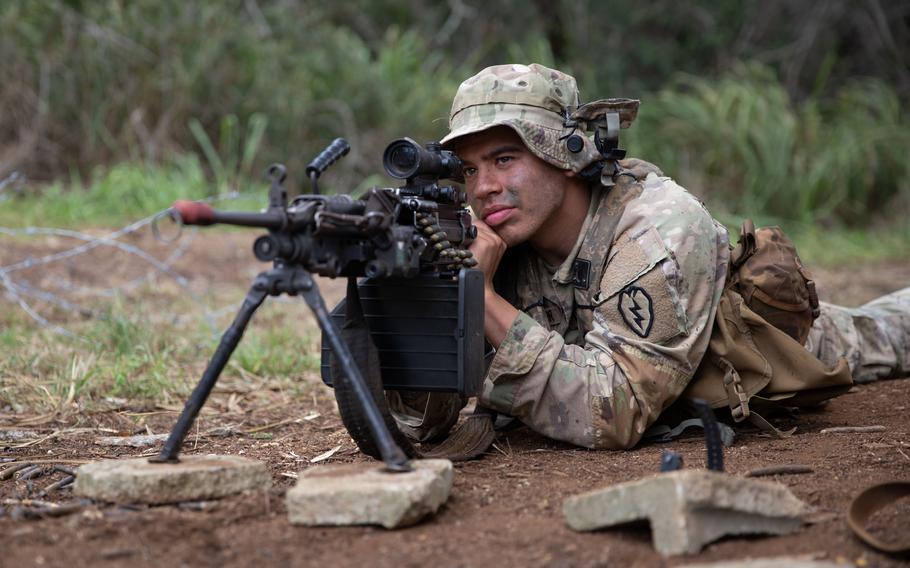
A soldier assigned to 3rd Infantry Brigade Combat Team, 25th Infantry Division pulls security at South Range on Schofield Barracks, Hawaii, during the Joint Pacific Multinational Readiness Center rotation in November 2023. (Michael Martin/U.S. Army)
FORT SHAFTER, Hawaii — Personnel from 10 nations will join in a massive 10-day Army exercise in Hawaii next month with drills taking place on three of the state’s islands.
The Joint Pacific Multinational Readiness Center kicks off training on Oct. 7 with soldiers fanning out across Oahu, Maui and the Big Island, the Army said in a news release Monday.
Now in its fourth year, the training focuses on one combat unit of the Hawaii-based 25th Infantry Division, centering this time on the 2nd Light Brigade Combat Team.
The combat training center is supported by U.S. Army Pacific and the 196th Infantry Brigade, both headquartered at Fort Shafter.
Military personnel from Malaysia, New Zealand, Indonesia, Thailand, Japan, Singapore, Maldives, Australia, Canada and the United Kingdom will also participate.
Other participating Army units will include the 25th Combat Aviation Brigade, 25th Division Artillery and the 25th Division Sustainment Brigade.
The JPMRC also operates a combat training center in Alaska, along with one that is deployable throughout the Indo-Pacific region.
The combat centers have personnel and equipment capable of providing realistic combat training of the kind soldiers would get at the Joint Readiness Training Center at Fort Johnson, La., or the National Training Center at Fort Irwin, Calif.
The training center was deployed in June to the Philippines for the first time. It had previously been deployed to Indonesia for Garuda Shield.
The training centers employ monitors, video and other digital information to provide real-time feedback to soldiers on the ground.
Training on Oahu will take place at Dillingham Army Airfield, Kahuku Training Area, Kawailoa Mountain Ranges, Helemanu Plantation and Schofield Barracks East and South Ranges.
Drills will be held at Pohakuloa Training Area on the Big Island and Puʻunene Hawaii National Guard Readiness Center and Kahului Airport on Maui.
The public can expect an increase in noise and traffic on all three islands, the Army said.
An increased number of helicopters, cargo planes and drones will be using Wheeler Army Airfield and Dillingham Army Military Reservation on Oahu; Bradshaw Army Airfield on Hawaii Island; and the National Guard Center and Kahului Airport on Maui.
The JPMRC combat centers are allowing soldiers to train in the environment, climate and conditions that they would likely face in the event of a conflict.
The JPMRC rotations train units and their leaders in austere conditions, whether that’s a humid jungle or snow-swept terrain, all while keeping them close to their home base.
Moving personnel and equipment for stateside training is not “optimal,” Gen. Charles Flynn, commander of U.S. Army Pacific, told reporters during last year’s JPMRC training.
“We would pack up an entire division’s worth of equipment and sail through the Panama Canal to Louisiana,” he said.
Soldiers were separated from their equipment for months as it was sent to the training center and then sent back. “And we just cannot afford to be going out of this region,” he said.